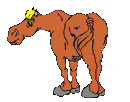Skin Conditions, bumps, clumps...
`Tis the Season for Skin Conditions

|
With the long hair our horses are growing for protection against the winter cold also comes skin problems most prevalent this time of year. The thick hair provides insulation for the organisms affecting the skin. With the addition of moisture from perspiration or rain we have the ideal environment for these organisms to grow! What we see or feel first is the rough texture of the hair coat. When we run our hand over the horse's rump, back, and shoulders we feel bumps within the hair coat.
Under the rough hair coat, you will most likely find clumps of hair matted together. You can pull these free, leaving a bare spot of skin. The horse may flinch when you do this as they can be quite tender.  This condition is due to a fungus with a secondary infection of bacteria. Both of these organisms are opportunists, which means they are around all the time. Only when the conditions are right for them do they cause a problem. The ideal conditions, according to them, are warm moist surfaces. The fungus invade the hair follicles, causing them to be inflamed. With this inflammation the follicle will ooze out its contents of sweat and oils. The hair shaft will become brittle and break. The area where this accumulates becomes raised and gives the hair coat that buckshot appearance so many of us have seen recently.
This condition is due to a fungus with a secondary infection of bacteria. Both of these organisms are opportunists, which means they are around all the time. Only when the conditions are right for them do they cause a problem. The ideal conditions, according to them, are warm moist surfaces. The fungus invade the hair follicles, causing them to be inflamed. With this inflammation the follicle will ooze out its contents of sweat and oils. The hair shaft will become brittle and break. The area where this accumulates becomes raised and gives the hair coat that buckshot appearance so many of us have seen recently.
A moist inflamed area is perfect for bacterial growth. The skin bacteria immediately start growing, causing additional inflammation and the moist pus-like material we see when we lift off one of those clumps. Allowed to go untreated, more of the skin will become affected, ultimately resulting in considerable hair loss.
From the above criteria for infection you probably have already decided on the approach we should take for treatment. It is only when the skin's defenses are down and the external conditions are right that infection occurs.
The above treatment will cure the condition causing the hair clumping and matting. It will take a few weeks to see new hair growing back within the denuded areas left from removing the clumps. This hair will be fine and hard to see at first but it will be there. If we start treatment as soon as we detect it, there will be less hair loss and a shorter time until Dobbin has back his winter coat for protection against the inevitable cold.
CLICK BELOW TO DISPLAY A PRINTER-FRIENDLY COPY OF THIS ARTICLE
Select "Open this file from its current location," if you just want to print it out,
it will open in a simple word processing application, select the print button.
(unless you want to save this article in your computer's memory)
In Rich Text File (.RTF) format:
TisTheSeasonForSkinConditions.rtf
In Adobe Acrobat (PDF) format:
TisTheSeasonForSkinConditions.pdf
